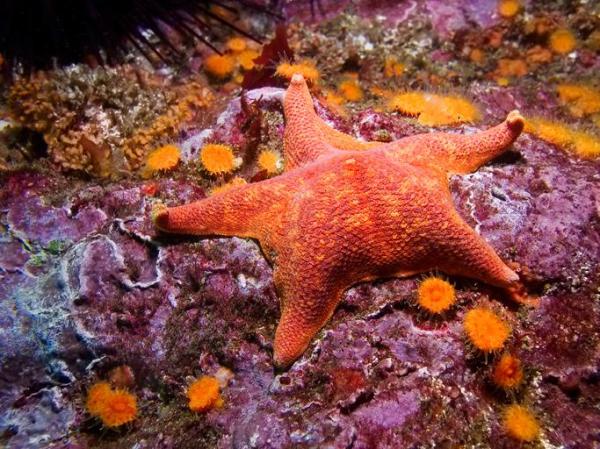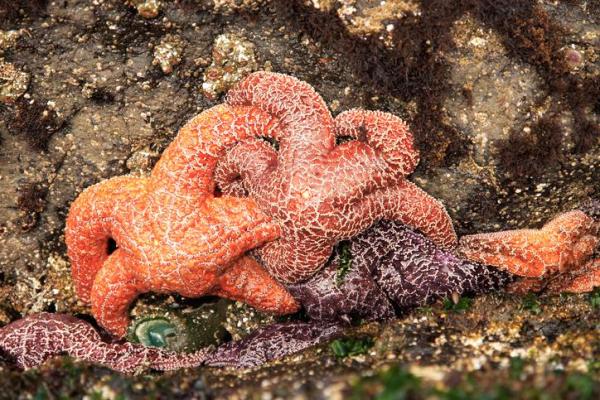How Are Starfish Born?


Starfish, commonly known as sea stars, have captivated people with their remarkable appearance and intriguing characteristics. These mesmerizing marine creatures are renowned for their distinctive star-shaped bodies, featuring five arms that radiate from a central disc. With their vibrant colors and intricate patterns, starfish never fail to capture our attention and admiration. However, have you ever wondered about the process of how starfish are born or what a baby starfish actually looks like?
In this article by AnimalWised, we delve into the captivating world of starfish, exploring the miraculous process of starfish birth, their intriguing life stages, and the remarkable methods they employ for reproduction.
What are starfish?
Starfish, also known as sea stars, are fascinating marine creatures that belong to the phylum Echinodermata. Starfish are invertebrates characterized by their spiny skin and radial symmetry. They are found in a wide range of marine habitats, from shallow coastal waters to the depths of the ocean.
One of the most recognizable features of starfish is their pentamerous radial symmetry. They typically have five arms, arranged symmetrically around a central disk. This radial symmetry allows starfish to move and orient themselves in any direction, giving them flexibility and agility in their marine environment. Also, the arms are flexible and can be used for various purposes, such as capturing prey, locomotion, and sensory perception.
The central disk serves as the main body region of a starfish. It contains vital organs, including the digestive system and the water vascular system, which helps in locomotion and feeding.
Starfish exhibit a remarkable diversity of species, with over 2,000 known species worldwide. This diversity manifests in various adaptations and characteristics among different starfish species. Different species of starfish can vary in terms of size, coloration, and arm shape.
Starfish play important ecological roles in marine ecosystems. They are known as keystone species, meaning they have a significant impact on the structure and functioning of their habitats. They help control the populations of prey species, such as mollusks and bivalves, and contribute to maintaining the balance of marine communities.
You might be interested in another article where we explore what starfish eat.
How do starfish reproduce?
Starfish reproduce through both sexual and asexual methods. Let's explore each of these reproductive strategies:
Sexual Reproduction
Starfish engage in sexual reproduction, which involves the fusion of gametes (sperm and eggs) from two individuals. The reproductive process typically involves the following steps:
- Breeding Season: Starfish species have specific times of the year when they engage in reproductive activities. During the breeding season, large numbers of males and females gather in the same area.
- Release of Gametes: Once gathered, the starfish individuals, either individually or in pairs, come into close contact with each other. Through rubbing and intertwining their arms, they engage in intimate contact, releasing certain substances that trigger the synchronized release of gametes (sperm and eggs) into the surrounding water.
- External Fertilization: In the majority of starfish species, fertilization occurs externally. The released sperm from males and eggs from females unite in the water, resulting in the formation of zygotes (fertilized eggs).
Asexual Reproduction
In addition to sexual reproduction, starfish are capable of asexual reproduction, which enables them to produce offspring without the involvement of gametes. Asexual reproduction in starfish primarily occurs through two methods:
- Fission or fragmentation: starfish can divide their central disk, often referred to as their body, into multiple parts. Each part retains a portion of the central disk along with associated legs, which allows for the regeneration of an entire individual. Essentially, from a single starfish, two new starfish can be produced. This process results in genetically identical offspring.
- Regeneration: starfish have remarkable regenerative abilities, enabling them to regrow lost body parts. If a starfish loses one or more arms, it can regenerate the lost arm(s) over time. In some cases, a complete starfish can regenerate from a single arm if it possesses enough of the central disk.
It's important to note that while sexual reproduction contributes to genetic diversity and the creation of new genetic combinations, asexual reproduction allows starfish to rapidly reproduce and colonize new areas without the need for a mate.
If you want to delve into the various methods of starfish reproduction, don't miss this additional article, where we provide an in-depth explanation of both sexual and asexual reproduction in starfish.

How are starfish born?
Starfish have a unique method of reproduction that differs from mammals and other animals. Instead of giving birth to live offspring, starfish undergo a process known as spawning. This involves the release of eggs and sperm into the water, where fertilization takes place.
Once the male and female starfish release their gametes, the fertilized eggs enter a period of development within protective membranes. Over time, the fertilized eggs undergo gradual changes, including cell division and differentiation. As the cells divide, an embryo forms and grows within the protective egg membrane.
After the development phase, the eggs hatch, and the young starfish emerge as larvae. This marks the transition from the enclosed egg stage to an independent life in the marine environment.
Upon hatching, the starfish larvae enter a planktonic life stage. They float and drift in the ocean currents, alongside other organisms in the plankton community. During this stage, their primary focus is on feeding, as it is crucial for their growth and development. The larvae actively search for food in the surrounding water, primarily consuming microorganisms that are part of the plankton community.
The planktonic stage is a critical period for starfish larvae. It is during this stage that they acquire the necessary energy and resources for their transformation into juvenile starfish. Successful growth and feeding in the larval stage provide the foundation for their transition into the next stage of the life cycle.
Finally, make sure to explore this additional article, where we provide a comprehensive overview of the diverse life stages and characteristics of starfish.
How is the starfish development?
Metamorphosis is a transformative process that starfish undergo during their development. They transitions from the larval stage to the juvenile stage. During this period, the starfish continues to grow and mature, gradually acquiring the characteristics and features of an adult starfish.
As the starfish larvae grow and undergo metamorphosis, they undergo significant changes in their body structure. The bilateral symmetry of the larvae transforms into radial symmetry, where their body parts are arranged symmetrically around a central axis. This transformation is a key milestone in the development of a starfish.
During metamorphosis, the larval body undergoes remodeling, resulting in the formation of arms. These arms grow and elongate, giving the starfish its distinctive appearance.
The juvenile starfish undergoes further morphological changes, including the development of tube feet along the undersides of their arms. These tube feet play a role in locomotion, feeding, and attachment to surfaces.
As the starfish reaches adulthood, it becomes sexually mature and capable of reproduction. Adult starfish engage in reproductive behaviors to ensure the continuation of their species.
Starfish have varying lifespans, which can range from a few years to several decades, depending on the species. Throughout their adulthood, starfish continue to grow, maintain their physiological functions, and contribute to the balance of their marine habitats.
If you want to read similar articles to How Are Starfish Born?, we recommend you visit our Facts about the animal kingdom category.
- Rivadeneira, PR, Martinez, MI, Penchaszadeh, PE, & Brogger, MI (2020). Reproduction and description of a new genus and species of deep-sea asteriid sea star (Echinodermata; Asteroidea) from the southwestern Atlantic. Deep Sea Research Part I: Oceanographic Research Papers, 163, 103348.
- Rivadeneira, PR, Brogger, MI, & Penchaszadeh, PE (2017). Aboral brooding in the deep water sea star Ctenodiscus australis Lütken, 1871 (Asteroidea) from the Southwestern Atlantic. Deep Sea Research Part I: Oceanographic Research Papers, 123, 105-109.
- Byrne, M. (1996). Viviparity and intragonadal cannibalism in the diminutive sea stars Patiriella vivipara and P. parvivipara (family Asterinidae) . Marine Biology, 125(3), 551-567.
Hickman, C. P. et al (2009): Comprehensive Principles of Zoology . McGraw-Hill, Madrid.






